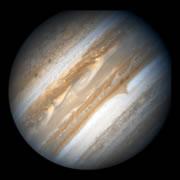 Jupiter: friend or foe?NASA / ESA / Hubble Heritage
Jupiter: friend or foe?NASA / ESA / Hubble HeritageFor more than a decade many astronomers have thought of Jupiter as a protective big brother for planet Earth. The gas giant's gravitational pull is believed to slingshot incoming Earth-threatening objects out of the Solar System. This has led many to suppose it shielded the young Earth from impacts, helping to support conditions for life.
But now, a preliminary study indicates that Earth would have done just as well, if not better — in at least one regard - without Jupiter's help.
The results of a study presented today at the European Planetary Science Congress in Potsdam, Germany, indicate that Earth would be struck — by one class of objects at least — at nearly the same rate, regardless of whether Jupiter was there or not. The findings are still tentative, cautions Jonathan Horner, an astronomer at the Open University in Milton Keynes who led the new work. But, he says, Jupiter's role as guardian may have been overstated: "It seems that the idea isn't so clear-cut."
The idea of Jupiter as protector was first proposed by planetary scientist George Wetherill in 19941. Wetherill showed that the planet's enormous mass — more than 300 times that of the Earth — is enough to catapult comets that might hit Earth out of the Solar System. Some have also postulated that Jupiter would thin the crowd of dangerous asteroids and other objects, making Earth a more stable home. Other work has suggested that, in the past, changes in Jupiter's orbit might have actually increased the number of objects on a collision course with earth. Until now, Horner says, little work was done to test either idea.
Modelling the Solar System
So Horner and colleague Barrie Jones built several versions of the Solar System on the Open University's computer cluster: one with a Jupiter, one without, and several with a gas giant that was either a quarter, half, or three-quarters of Jupiter's mass. The system also contained 100,000 centaurs — large, icy bodies from the Solar System's Kuiper belt, within which Pluto lies.
After running their models for 10 million virtual years, Horner and Jones found some striking results. The Earth was about 30% more likely to be hit by a centaur in a Solar System with a life-size Jupiter than it was in a Jupiter-less system.
Things looked even worse when there was an intermediate-sized planet in Jupiter's place, according to Horner. A lighter version of Jupiter could help pull the centaurs into the inner Solar System, while lacking the gravity to heave them back out. As a result, a planet with a quarter of Jupiter's mass could increase the chances of a strike on Earth by nearly 500% when compared to a system with no planet there.
More belts
"It's a good speculative paper," says Mark Bailey, director of the Armagh Observatory in Northern Ireland and an expert on Earth-impacting asteroids. However, Bailey adds, it fails to take into account Jupiter's ability to deflect Earth-colliding objects from the Oort cloud, a massive cloud of comets that surrounds the Solar System.
ADVERTISEMENT
Nor does it factor in the most likely source of a hit, according to Alessandro Morbidelli, an astronomer at the Observatoire de la Cote d'Azur, in Nice, France. The asteroid belt between Mars and Jupiter accounts for all but a small percentage of the Earth-crossing objects in the Solar System, Morbidelli says. To really understand Jupiter's role as a protector will require a calculation of how the planet influences those many, smaller objects. "That's a much more complicated thing to do," Morbidelli says.
Horner says that he and his colleagues will soon begin work on simulations of both the Oort cloud comets and asteroid belt objects.
Visit our protectivepull_quest.html">newsblog to read and post comments about this story.
director Armagh Observatory, Northern Ireland
